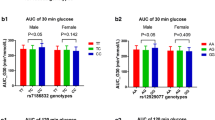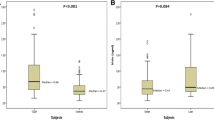Abstract
Alpha2 Heremans-Schmid glycoprotein (AHSG) is a plasma protein inhibiting the activity of the insulin receptor tyrosine kinase. Ahsg knock-out mice have increased insulin sensitivity and are resistant to diet-induced obesity. We hypothesized that functional variants of the AHSG gene segregating in the human population would reflect variation in body mass index (BMI). We genotyped 356 overweight or obese (BMI: 37.2 [25.0–66.5] kg/m2) and 148 lean (BMI: 23.7 [23.4–24.9] kg/m2) otherwise healthy Swedish men for three non-synonymous single-nucleotide polymorphisms (SNPs) within exon 6 (rs4917) and exon 7 (rs4918 and Arg299Cys) and one SNP in intron 1 (rs2593813) of the AHSG gene. The G/G genotype for rs2593813 was more common among lean than among obese and overweight individuals (odds ratio=2.01, P=0.009), whereas rs2593813 was in strong linkage disequilibrium (|D′| ≥ 0.97) with rs4917 and rs4918. Homozygosity for the rs2593813:G–rs4917:Met–rs4918:Ser haplotype conferred an increased risk for leanness (odds ratio=1.90, P=0.027). rs4917:Met and rs4918:Ser have previously been associated with lower AHSG protein level. A common variant of AHSG, previously associated with a lower AHSG protein level, is thus more common among lean than obese and overweight men, supporting the results from Ahsg knock-out mice, namely, that AHSG modulates body mass.
Similar content being viewed by others
References
Akhoundi C, Amiot M, Auberger P, Le Cam A, Rossi B (1994) Insulin and interleukin-1 differentially regulate pp63, an acute phase phosphoprotein in hepatoma cell line. J Biol Chem 269:15925–15930
Allison MA, Wright CM (2004) Body morphology differentially predicts coronary calcium. Int J Obes 28:396–401
Auberger P, Falquerho L, Contreres JO, Pages G, Le Cam G, Rossi B, Le Cam A (1989) Characterization of a natural inhibitor of the insulin receptor tyrosine kinase: cDNA cloning, purification and anti-mitogenic activity. Cell 58:631–640
Banine F, Gangneux C, Mercier L, Le Cam A, Salier JP (2000) Positive and negative elements modulate the promoter of the human liver-specific α2-HS-glycoprotein gene. Eur J Biochem 267:1214–1222
Burke AP, Weber DK, Kolodgie FD, Farb A, Taylor AJ, Virmani R (2001) Pathophysiology of calcium deposition in coronary arteries. Herz 26:239–244
Cartegni L, Wang J, Zhu Z, Zhang MQ, Krainer AR (2003) ESEfinder: a web resource to identify exonic splicing enhancers. Nucleic Acids Res 31:3568–3571
Colditz GA, Willet WC, Rotnitzky A, Manson JF (1995) Weight gain as a risk factor for clinical diabetes mellitus in women. Ann Intern Med 22:481–486
Dahlman I, Eriksson P, Kaaman M, Jiao H, Lindgren CM, Kere J, Arner P (2004) α2-Heremans-Schmid glycoprotein gene polymorphisms are associated with adipocyte insulin action. Diabetologia 47:1974–1979
Daveau M, Davrinche C, Djelassi N, Lemetayer J, Julen N, Hiron M, Arnaud P, Lebreton JP (1990) Partial hepatectomy and mediators of inflammation decrease the expression of liver α2-HS glycoprotein gene in rats. FEBS Lett 273:79–81
Dvornyk V, Liu X-H, Shen H, Lei S-F, Zhao L-J, Huang Q-R, Qin Y-J, Jiang D-K, Long J-R, Zhang Y-Y, Gong G, Recker RR, Deng H-W (2003) Differentiation of Caucasians and Chinese at bone mass candidate genes: implication for ethnic difference of bone mass. Ann Hum Genet 67:216–227
Dziegielewska KM, Brown WM (1995) Fetuin. Springer, Berlin Heidelberg New York
Gangneux C, Daveau M, Hiron M, Derambure C, Papaconstantinou J, Salier JP (2003) The inflammation-induced down-regulation of plasma fetuin-A (α2HS-glycoprotein) in liver results from the loss of interaction between long C/EBP isoforms at two neighbouring binding sites. Nucleic Acids Res 31:5957–5970
Grimble RF (2002) Inflammatory status and insulin resistance. Curr Opin Clin Nutr Metab Care 5:551–559
Jahnen-Dechent W, Schinke T, Trindl A, Muller-Esterl W, Sablitzky F, Kaiser S, Blessing M (1997) Cloning and targeted deletion of the mouse fetuin gene. J Biol Chem 272:31496–31503
Juge-Aubry CE, Somm E, Chicheportiche R, Burger D, Pernin A, Cuenod-Pittet B, Quinodoz P, Giusti V, Dayer JM, Meier CA (2004) Regulatory effects of interleukin (IL)-1, interferon-beta, and IL-4 on the production of IL-1 receptor antagonist by human adipose tissue. J Clin Endocrinol Metab 89:2652–2658
Kalabay L, Cseh K, Pajor A, Baranyi E, Csákány GM, Melczer Z, Speer G, Kovács M, Siller G, Karádi I, Winkler G (2002) Correlation of maternal serum fetuin/α2-HS-glycoprotein concentration with maternal insulin resistance and anthropometric parameters of neonates in normal pregnancy and gestational diabetes. Eur J Endocrinol 147:243–248
Ketteler M, Bongartz P, Westenfeld R, Wildberger J.E., Mahnken AH, Bohm R, Metzger T, Wanner C, Jahnen-Dechent W, Floege J (2003) Association of low fetuin-a (AHSG) concentrations in serum with cardiovascular mortality in patients on dialysis: a cross-sectional study. Lancet 361:327–333
Kissebah AH, Sonnenberg GE, Myklebust J, Goldstein M, Broman K, James RG, Marks JA, Krakower GR, Jacob HJ, Weber J, Martin L, Blangero J, Comuzzie AG (2000) Quantitative trait loci on chromosomes 3 and 17 influence phenotypes of the metabolic syndrome. Proc Natl Acad Sci USA 97:14478–14483
Lin X, Braymer HD, Bray GA, York DA (1998) Differential expression of insulin receptor tyrosine kinase inhibitor (fetuin) gene in a model of diet-induced obesity. Life Sci 63:145–153
Mathews ST, Singh GP, Ranalletta M, Cintron VJ, Qiang X, Goustin AS, Jen K-LC, Charron MJ, Jahnen-Dechent W, Grunberger G (2002a) Improved insulin sensitivity and resistance to weight gain in mice null for the Ahsg gene. Diabetes 51:2450–2448
Mathews ST, Deutsch DD, Iyer G, Hora N, Pati B, Marsh J, Grunberger G (2002b) Plasma α2-HS glycoprotein concentrations in patients with acute myocardial infarction quantified by a modified ELISA. Clin Chim Acta 319:27–34
Matsuki T, Horai R, Sudo K, Iwakura Y (2003) IL-1 plays an important role in lipid metabolism by regulating insulin levels under physiological conditions. J Exp Med 198:877–888
Osawa M, Umetsu K, Sato M, Ohki T, Yukawa N, Suzuki T, Takeichi S (1997) Structure of the gene encoding human alpha 2-HS glycoprotein (AHSG). Gene 196:121–125
Osawa M, Yuasa I, Kitano T, Henke J, Keneko M, Udono T, Saitou N, Umetso K (2001) Haplotype analysis of the human α2-HS glycoprotein (fetuin) gene. Ann Hum Genet 65:27–34
Osawa M, Tian W, Horiuchi H, Kaneko M, Umetsu K (2005) Association of α2-HS glycoprotein (AHSG, fetuin-A) polymorphism with AHSG and phosphate serum levels. Hum Genet 116:146–151
Schafer C, Heiss A, Schwarz A, Westenfeld R, Ketteler M, Floege J, Muller-Esterl W, Schinke T, Jahnen-Dechent W (2003) The serum protein alpha 2-Heremans-Schmid glycoprotein/fetuin-A is a systemically acting inhibitor of ectopic calcification. J Clin Invest 112:357–366
Schinke T, Amendt C, Trindl A, Poschke O, Muller-Esterl W, Jahnen-Dechent W (1996) The serum protein alpha2-HS glycoprotein/fetuin inhibits apatite formation in vitro and in mineralizing calvaria cells. A possible role in mineralization and calcium homeostasis. J Biol Chem 271:20789–20796
Schneider S, Roessli D, Excoffier L (2000) Arlequin ver. 2.000: a software for population genetics data analysis. Genetics and Biometry Laboratory, University of Geneva, Switzerland
Sham P (1998) Statistics in human genetics. In: Everitt B (ed) Arnold applications of statistics. Wiley, London
Sowers JR (2004) Insulin resistance and hypertension. Am J Physiol Heart Circ Physiol 286:H1597–H1602
Srinivas PR, Wagner AS, Reddy LV, Deutsch DD, Leon MA, Goustin AS, Grunberger G (1993) Serum alpha2-HS-glycoprotein is an inhibitor of the human insulin receptor at the tyrosine kinase level. Mol Endocrinol 7:1445–1455
Stenvinkel P, Wang K, Axelsson J, Pecoits-Filho R, Gao P, Barany P, Lindholm B, Jogestrand T, Heimbürger O, Hoff C, Holmes C, Sengül S, Schalling M, Nordfors L (2005) Low serum fetuin-A levels predict atherosclerosis and mortality in end-stage renal disease patients and are associated with malnutrition, inflammation, atherosclerosis and genetic variations in the gene (AGSH) encoding fetuin. Kidney Int (in press)
Streeten DH, Anderson GH (1992) Secondary hypertension. An overview of its causes and management. Drugs 43:805–819
Suzawa M, Takada I, Yanagisawa J, Ohtake F, Ogawa S, Yamauchi T, Kadowaki T, Shibuya H, Gotoh Y, Matsumoto K, Kato S (2003) Cytokines suppress adipogenesis and PPAR-gamma function through the TAK1/TAB1/NIK cascade. Nat Cell Biol 5:224–230
Terauchi Y, Tsuji Y, Satoh S, Minoura H, Murakami K, Okuno A, Inukai K, Asano T, Kaburagi Y, Ueki K, Nakajima H, Hanafusa T, Matsuzawa Y, Sekihara H, Yin Y, Barrett JC, Oda H, Ishikawa T, Akanuma Y, Komuro I, Suzuki M, Yamamura K, Kodama T, Suzuki H, Kadowaki T (1999) Increased insulin sensitivity and hypoglycaemia in mice lacking the p85 alpha subunit of phosphoinositide 3-kinase. Nat Genet 21:230–235
Vionnet N, Hani El-H, Dupont S, Gallina S, Francke S, Dotte S, De Matos F, Durand E, Lepretre F, Lecoeur C, Gallina P, Zekiri L, Dina C, Froguel P (2000) Genomewide search for type 2 diabetes-susceptibility genes in French whites: evidence for a novel susceptibility locus for early-onset diabetes on chromosome 3q27-qter and independent replication of a type 2-diabetes locus on chromosome 1q21-q24. Am J Hum Genet 67:1470–1480
Zienolddiny S, Ryberg D, Maggini V, Skaug V, Canzian F, Haugen A (2004) Polymorphisms of the interleukin-1 beta gene are associated with increased risk of non-small cell lung cancer. Int J Cancer 109:353–356
Acknowledgements
The skilful assistance of Britt-Marie Leijonhufvud, Katarina Hertel, Eva Sjölin, Kerstin Wåhlèn, Elisabeth Dungner and Selim Sengul is greatly acknowledged. This study was supported by grants from Swedish Medical Research Council, Swedish Diabetes Association and Novo Nordic Foundation.
Author information
Authors and Affiliations
Corresponding author
Rights and permissions
About this article
Cite this article
Lavebratt, C., Wahlqvist, S., Nordfors, L. et al. AHSG gene variant is associated with leanness among Swedish men. Hum Genet 117, 54–60 (2005). https://doi.org/10.1007/s00439-005-1286-z
Received:
Accepted:
Published:
Issue Date:
DOI: https://doi.org/10.1007/s00439-005-1286-z




